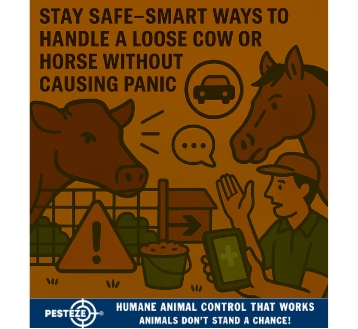HOW TO HANDLE A LOOSE COW OR HORSE

HOW TO HANDLE A LOOSE COW OR HORSE
SUMMARY
A loose cow or horse can pose serious risks to traffic, property, and personal safety. Whether it’s a gate left open or a fence breach, knowing how to respond calmly and effectively is key. This guide provides humane, low-stress strategies to recover large livestock safely and prevent future escapes.
FEATURES
-
Stay Calm and Assess: Avoid chasing—observe the animal’s behavior and surroundings first.
-
Use Familiar Lures: Buckets of feed, halters, or companions can help coax the animal back.
-
Control the Environment: Block roads, close gates, and remove distractions to reduce risk.
-
Approach Strategically: Move slowly from behind or at an angle to guide without startling.
-
Have Backup Ready: Enlist help from neighbors or handlers to create a safe perimeter.
-
Secure and Inspect Fencing: Once recovered, check for damage and reinforce weak points.
GUIDE DESCRIPTION
When a cow or horse gets loose, the situation can escalate quickly. These animals are large, powerful, and easily spooked—especially in unfamiliar environments. Whether they’ve wandered into a road, pasture, or neighborhood, your first priority is safety.
Start by staying calm. Running or yelling will only increase the animal’s stress and make them harder to catch. Observe their behavior: are they grazing, pacing, or panicked? This will guide your approach.
Use familiar lures. A bucket of grain, a halter, or even another animal from the herd can help coax them back. Many cows and horses respond well to routine cues, so use what they know.
Control the environment. If the animal is near a road, block traffic and alert neighbors. Close gates and remove distractions like barking dogs or loud machinery. A quiet, controlled space makes recovery easier.
Approach strategically. Never walk directly toward the animal’s face—this can trigger a defensive reaction. Instead, move slowly from behind or at a slight angle, using calm body language. For horses, avoid sudden movements and speak softly.
Backup is essential. Enlist help from experienced handlers or neighbors to form a perimeter. Use long ropes or panels to gently guide the animal toward a secure area. Avoid cornering or pressuring them too quickly.
Once the animal is secured, inspect the area for escape points. Check fencing, gates, and latches for damage or wear. Reinforce weak spots and consider adding signage or locks to prevent future incidents.
Handling a loose cow or horse requires patience, awareness, and teamwork. With the right approach, you can recover your animal safely and strengthen your farm’s security.
- Amy Chang


Comments 0